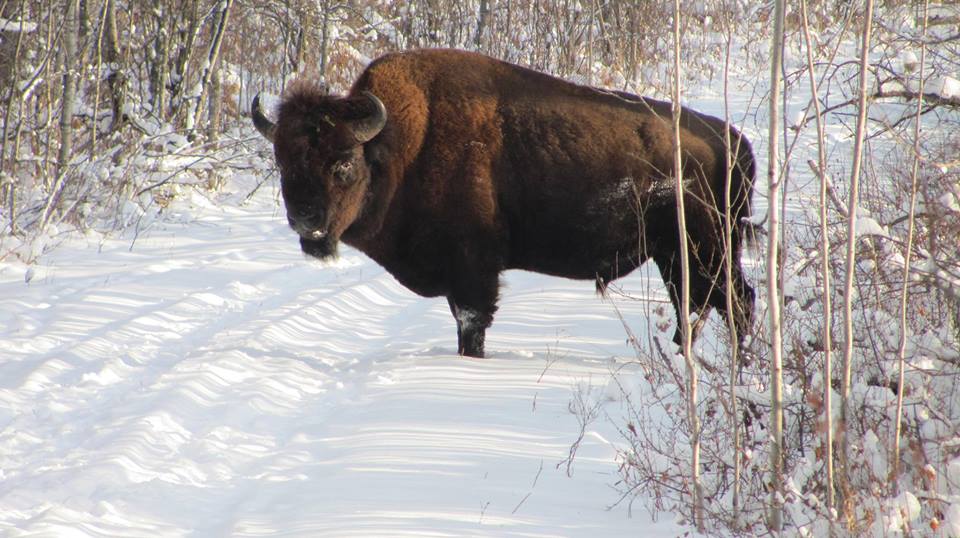What’s needed next for Canada’s Bison?

Recently, I turned the page on a wonderful chapter of my life. Until a year ago, in addition to my work with CPAWS-Saskatchewan, I also owned Sturgeon River Ranch on the southwest boundary of Prince Albert National Park. The Ranch is well known for taking guests on horseback into Prince Albert National Park to view Canada’s only herd of Plains bison still roaming free in their historic range. I recently sold the operation to a good friend of mine and he is continuing this work.
One of the best things about this work was the opportunity I had to view the Sturgeon River Plains bison herd on a regular basis. Over the years, we became quite familiar with each other. I also became very familiar with the efforts being made to conserve these bison. Back in 2005, I jumped in with both feet and began my career as a conservationist by co-founding the Sturgeon River Plains Bison Stewards, an organization of local ranchers and other concerned folks built on the premise that we needed to preserve this population for generations to come. Our group successfully brought many people together to support this cause, including First Nations, the provincial government, Parks Canada, and several environmental non-governmental organizations (ENGOs). In 2010, the Stewards hosted a very successful international wild bison symposium entitled “Bison on the Edge.” A couple of years later, the Stewards led the development of a management plan for the herd that was ultimately adopted by both Parks Canada and the Province of Saskatchewan, and which still serves today as the guiding document in management decisions for this important population.
But that was then.
Today, the Sturgeon River Plains bison herd is in crisis. The population is dropping fast and shows no sign of improving in the near future: there are now between 150 and 200 bison, compared to the close to 500 bison that were present in 2005. The dramatic decline started because of an anthrax outbreak in 2008. Additionally, the population experiences harvesting pressure when the bison roam outside Prince Albert National Park between July and November. Approximately 30 bison are harvested by treaty hunters exercising their traditional land use rights each year. We’ve consistently seen around 30 bison harvested each year. To put that in perspective, it is estimated that only 10 calves were born this year. The math is not on our side.
Meanwhile in Alberta, Parks Canada and many others are rightfully celebrating with great fanfare the return of free ranging Plains bison to Banff National Park. I’m pretty stoked about it too, and even got to help out a bit along the way, for which I’m thankful. However, as we celebrate the return of bison to Banff National Park, we mustn’t lose sight of the plight of the Sturgeon River bison in Prince Albert National Park, which urgently need more attention in order to survive. As we’ve celebrated Banff, we’ve taken our eyes off the Sturgeon River bison, and it appears that this population’s speedy decline towards extirpation is largely going unnoticed.
What can be done?
A wonderful recent development is the Buffalo Treaty. While largely an idea born out of the goals of the Blackfoot people to establish new bison populations in southern Alberta and northern Montana, this Nation-to-Nation treaty provides an opportunity for First Nations across North America’s historic bison range to take leadership in bison conservation and rebuild traditional relationships. I’m excited that First Nations associated with the Sturgeon River herd have decided to sign the Treaty this fall, and have great hope that this can help support a collaborative effort to save the Sturgeon River bison herd. Through our involvement with the Treaty, we have been working with the First Nations elders and leaders, many of which are also very concerned about the effect of the bison harvest on the Sturgeon River population, and to address how to reconcile bison survival with traditional hunting practices of First Nations people in Saskatchewan.
Listing Plains bison as Threatened under the Federal Species at Risk Act (SARA) would also be extremely helpful. The Committee on the Status of Endangered Wildlife in Canada (COSEWIC – the scientific body that assesses and recommends listings for SARA) has been recommending this listing since 2004, reconfirming this recommendation again in 2013. Listing of Plains bison would provide access to funding for conservation projects by local ranchers, the Sturgeon River Plains Bison Stewards and others through the Habitat Stewardship Program, while also making it easier to implement hunting bans. Until this listing occurs, ranchers and stakeholders on the SW boundary of Prince Albert National Park will continue to be forced to undertake conservation initiatives out of their own pockets, while they watch the Sturgeon River bison (and their years of hard work to conserve them) disappear.
In order to ensure that the introduction of bison back to Banff is an ongoing success for Parks Canada, equal attention needs to be paid by the organization to ensuring the species survives and thrives in and around national parks with established populations. The reintroduction of bison to Canada’s first national park is indeed something to celebrate; the maintenance of the species’ full historic range and the Sturgeon River herd is equally important.
What the bison conservation movement needs now is focussed attention on restoring the health of the magnificent Sturgeon River bison herd that roams freely in and around beautiful Prince Albert National Park in Saskatchewan. And may I recommend that you make the trip to these magnificent creatures for yourself, and that you do so from the back of a horse!
Gord Vaadeland
